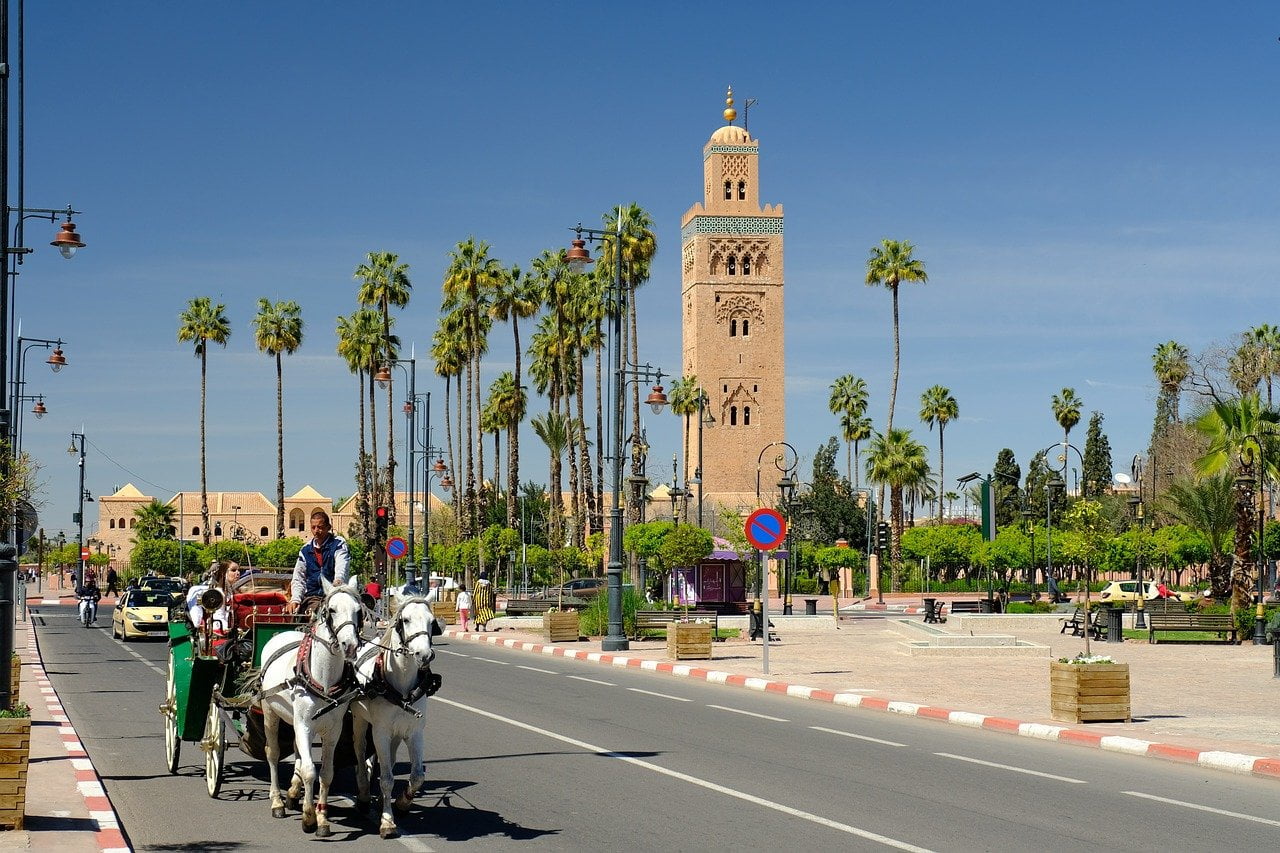Home » Places to Visit in Morocco » What Should First-Time Visitors Know in Marrakech?
Planning Your Trip
When to Visit:
Marrakech’s climate ranges from the cool breezes of spring to the scorching heat of summer. Visiting during March to May or September to November offers pleasant weather, ideal for wandering through the endless maze of souks or enjoying the many outdoor cafes without the oppressive heat. These months also coincide with several cultural festivals, providing a deeper insight into the local traditions and celebrations.
Understanding Local Culture:
Marrakech is steeped in history and tradition. As a Muslim-majority city, it is important for visitors to dress conservatively, especially when visiting mosques and religious sites. Shoulders and knees should be covered, and women might consider carrying a scarf to cover their heads as a sign of respect. Learning a few basic Arabic phrases not only helps in navigating the city but also shows respect for the local culture, enhancing interactions with the residents who are known for their warm hospitality.
Accommodation: Choosing Your Base
Riads in Marrakech:
Riads are traditional Moroccan houses with an interior garden or courtyard, offering a unique and authentic lodging experience. These accommodations range from the simple and quaint to the luxuriously opulent, often featuring intricate tile work, plush courtyards, and rooftop terraces that offer spectacular views of the city skyline. Many riads are conveniently located within the medina, providing easy access to major sites while offering a quiet, serene place to retreat after a day of exploration.
Navigating Marrakech
The medina, a UNESCO World Heritage site, is a tightly woven labyrinth of alleyways and bustling markets and is best explored on foot. For destinations outside the medina, such as the Majorelle Garden or the Palmeraie, taxis are readily available. It’s advisable to agree on the fare in advance to avoid any confusion or overcharging. Some taxi drivers may not use meters, so negotiating the fare before starting your journey is crucial.
Must-Visit Places
Jemaa el-Fna Square:

During the day, this large square at the heart of the medina serves as a market place where you can find fruit stalls, snake charmers, and wandering musicians. As the sun sets, the square transforms into a buzzing hub of activity, with storytellers, magicians, and rows of food stalls filling the air with delicious smells. Sampling street food here, such as grilled meats and traditional pastries, is a must.
Marrakech’s Medina:
The medina is not just the historical heart of the city; it’s the cultural and social centre where life has pulsed for centuries. Within its red walls, you’ll discover a world of commerce in the bustling souks, selling everything from spices and textiles to artisanal crafts. Key historical sites such as the Bahia Palace and the Ben Youssef Madrasa offer glimpses into Marrakech’s rich past.
Eating Out: Restaurants, Cafes, and Street Food
Marrakech’s culinary scene is a rich tapestry that blends traditional Moroccan flavours with international influences. For those looking to indulge in local cuisine, the Dar Yacout in the medina offers not just a meal but an experience, with its grand courtyard and traditional Moroccan dishes like pastilla and lamb tagine. Le Fondouk is another medina gem where the rooftop seating offers panoramic views to enjoy alongside your meal.
Shopping: Marrakech Souks
The souks are the commercial hub of the medina, offering a seemingly endless array of goods. Each souk specialises in a particular craft: carpets in one, spices and teas in another, and intricate lanterns and metalwork in another. Bargaining is part of the shopping experience; starting your offer at about half the asking price is a good rule of thumb.
Safety Tips
While Marrakech is generally safe for tourists, solo travellers, and particularly women, should exercise caution. Stay alert in crowded areas where pickpocketing can occur. It’s best to carry minimal cash and use a secure bag. Solo female travellers should consider dressing conservatively to blend in and avoid unwanted attention. Be cautious of locals offering unsolicited help or tours, as they may ask for hefty tips or take you to shops where they get commissions. Always plan your route beforehand, and it’s advisable to have a reliable contact or app to use in case you need assistance.
Dealing with Mosquitoes in Marrakech
Especially prevalent during the warmer months, mosquitoes can be a nuisance. Using a strong insect repellent and wearing clothing that covers the arms and legs in the evenings can help prevent bites. Most hotels and riads provide mosquito nets over beds as an additional precaution.
A Perfect Choice for a Family Holiday
A family holiday in Morocco is a fantastic choice, offering a variety of activities that are sure to delight children. Kids can explore the bustling souks, marvel at snake charmers and street performers in Jemaa el-Fnaa square, and enjoy a day at the Oasiria Water Park. For an adventurous experience, camel rides in the Agafay Desert provide an unforgettable experience. Interactive museums like the Maison de la Photographie offer engaging cultural insights, while cooking classes give children a hands-on experience with Moroccan cuisine.
Day Trips from Marrakech:
Practical Information
The Moroccan Dirham is the only currency officially accepted for transactions. While major credit cards are accepted in hotels and upscale restaurants, cash is still king in the souks and smaller eateries. Arabic is the official language, with French widely understood. Berber languages are spoken primarily in rural areas, though English is increasingly common among the younger population and in tourist areas.
Conclusion
Marrakech is a city that offers endless exploration opportunities. With its rich history, vibrant culture, and bustling markets, there is something to captivate every visitor. Whether you’re wandering through the aromatic alleys of the souks, enjoying the serene beauty of a riad, or venturing into the surrounding landscapes, Marrakech promises an adventure that combines the mystique of the past with the vibrant pulse of the present.

 Marrakech, known as the Red City, is a lively city that engages all your senses. As the sun comes up over the Koutoubia Mosque and until the lively evening bustle in Jemaa el-Fnaa Square, the city offers a true taste of Moroccan life. This guide aims to help first-time visitors get to grips with this busy city, ensuring they have a fulfilling trip packed with memorable moments.
Marrakech, known as the Red City, is a lively city that engages all your senses. As the sun comes up over the Koutoubia Mosque and until the lively evening bustle in Jemaa el-Fnaa Square, the city offers a true taste of Moroccan life. This guide aims to help first-time visitors get to grips with this busy city, ensuring they have a fulfilling trip packed with memorable moments.











